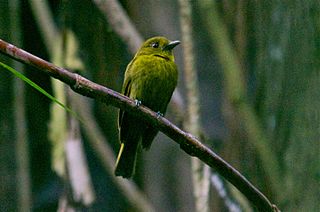
The sapayoa or broad-billed sapayoa is a suboscine passerine bird found Colombia, Ecuador, and Panama.
The tapping nursery frog is a species of frog in the family Microhylidae.
Nesiocypraea aenigma is a species of sea snail, a cowry, a marine gastropod mollusk in the family Cypraeidae, the cowries.

Cypraea is a genus of medium-sized to large sea snails or cowries, marine gastropod mollusks in the family Cypraeidae, the cowries.

Nesiocypraea is a genus of sea snails, marine gastropod mollusks in the family Cypraeidae, the cowries.

Habuprionovolva basilia is a species of sea snail, a marine gastropod mollusk in the family Ovulidae, the ovulids, cowry allies or false cowries.
Habuprionovolva hervieri is a species of sea snail, a marine gastropod mollusk in the family Ovulidae, the ovulids, cowry allies or false cowries.
Habuprionovolva umbilicata is a species of sea snail, a marine gastropod mollusk in the family Ovulidae, the ovulids, cowry allies or false cowries.

Habuprionovolva is a genus of sea snails, marine gastropod mollusks in the family Ovulidae.
Prionovolva is a genus of sea snails, marine gastropod mollusks in the family Ovulidae.
Aenigma is a genus of ground beetles in the family Carabidae. This genus has a single species, Aenigma iris, found in eastern Australia.

Dugesia aenigma is a species of dugesiid triclad that inhabits freshwater bodies of Cephalonia, Greece.
Carpatolechia aenigma is a moth of the family Gelechiidae. It is found in France, Germany, the Netherlands, Italy, Austria, the Czech Republic, Slovakia, Poland, Hungary, Romania, Greece, Ukraine and Russia.

Acrodontis aenigma is a species of moth in the family Geometridae. It is found in Taiwan.
Nepenthes aenigma is a tropical pitcher plant known from two mountains in Ilocos Norte province on the Philippine island of Luzon, where it grows at an elevation of around 1200 m above sea level. The species is notable for growing among dense vegetation in deep shade. It shows similarities to N. burkei and N. ventricosa.

Hakea aenigma, commonly known as the enigma hakea, is a shrub in the family Proteaceae native to South Australia. Only one of two Hakea species totally reliant on suckering to reproduce therefore have "reached evolutionary dead-ends".
Pterostylis × aenigma, commonly known as enigmatic greenhood, is a species of orchid endemic to Victoria in Australia. It has a rosette of leaves and a single green and white flower which leans forward and has a brownish point on the end. It is a rare orchid, occurring at only one site with fewer than 100 individual plants and is thought to be a natural hybrid between two species that grow nearby.

Asterodiscididae is a family of starfish. Members of the family have five short tapering arms and a wide disc. The family was first described by the Australian zoologist F.W.E. Rowe in 1977.
Cenaspis aenigma is a species of colubrid snake in the subfamily Dipsadinae and the only member of the monotypic genus Cenaspis. It is endemic to the highlands of western Chiapas, Mexico, where it was described from a single, partially digested male specimen found in the stomach of a Central American coral snake. This is referenced in its generic name, as cena is Spanish for "dinner". Despite being partially digested, the specimen still displayed many unique traits, including undivided subcaudals for the full length of the tail, as well as a simple hemipenis completely covered in calyces with a largely non-bifurcated sulcus spermaticus. These traits are not known from any other colubroid snake in the Western Hemisphere.
Carlia aenigma is a species of skink, commonly known as the enigmatic rainbow skink, in the genus Carlia. It is endemic to Papua New Guinea.







